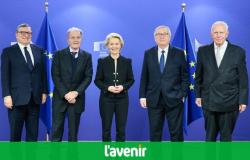Ukraine is beginning to consider moving away from the US dollar, perhaps by linking its currency more to the euro in a context of fragmentation of global trade and strengthening its links with Europe, the Governor of the Central Bank, Andriy Pyshnyi told Reuters.
Potential membership of the European Union, “strengthening the role of the EU in the guarantee of our defense capacities, the greatest volatility in global markets and the probability of fragmentation of global trade” oblige the central bank to re -examine if the euro should replace the dollar as a reference currency for the Ukrainian Hryvnia, said Mr. Pyshnyi in a statement sent by electronic mail.
“This work is complex and requires high -quality and versatile preparation,” added Mr. Pyshnyi, in the most direct comments of a Ukrainian official on a possible change. The dollar dominates international trade and represents the majority of world reserves. Large economies, including Saudi Arabia and Hong Kong, have indexed their currency on the dollar. But under the presidency of Donald Trump, the United States has sparked a trade war by introducing what could be the highest customs duties in a century, a decision that has led some observers to question the future role of the dollar as a global reserve currency. Today, when she has been fighting for four years against the Russian invasion, Ukraine also saw Trump temporarily suspend part of the military aid he granted her. European leaders, including those of the EU, are committed to strengthening kyiv’s army so that it can be the cornerstone of future security in Ukraine, but progress has been difficult. At the same time, Ukraine has concluded an agreement which gives the United States preferential access to new Ukrainian mining contracts and which finances investments in the reconstruction of the country.
Since Trump’s return to the White House, the greenback has lost more than 9 % compared to a basket of major currencies, investors withdrawn from American assets. Some experts warn against associating the strength of the dollar with its status of reserve currency. However, historically, dollars’ reserves have always been linked to security alliances and military links with Washington.
US dollars transactions continue to dominate all segments of the exchange market, said Pyshnyi, but the share of transactions labeled in euros has increased in most segments, although “moderately so far”. He did not give more details.
Ukraine launched Hryvnia in 1996 and for decades, it used the dollar as a reference currency.
Immediately after the Russian invasion in February 2022, the central bank imposed capital controls and set the official Hryvnia rate at around 29 for an American dollar. Ukraine was then forced to devalue its currency due to an increasing budgetary imbalance.
In October 2023, the central bank went from a fixed parity regime to a controlled exchange rate regime which uses the US dollar as a reference, that is to say as an indicator to measure interventions on the exchange market and to smooth fluctuations in the exchange rate. The EU started negotiations for membership with Ukraine and Moldova almost a year ago, but the path will be long and difficult before these countries could join the Union. EU president Ursula von der Leyen, said in February that Ukraine could adhere by 2030 provided that he continues his political and judicial reforms at the current rate. In anticipation of this membership, Moldova replaced the dollar with the euro as a reference currency on January 2. According to Mr. Pyshnyi, the resumption of investments and consumption thanks to rapprochement with Europe and economic standardization should contribute to a slight acceleration of economic growth over the next two years, to reach 3.7 to 3.9 %, even if the evolution of the conflict will remain decisive for economic trajectory.
“A rapid end of war would clearly be a positive scenario with good economic results if it included security guarantees for Ukraine,” said Pyshnyi.
“Nevertheless, it is essential to recognize that the economic benefits of the end of the war would probably take time to fully materialize. »»
Ukraine depends on external funding to finance the war effort. Mr. Pyshnyi said he was expecting to receive $ 55 billion this year, which would not only cover the budget deficit, but also to build a public finance reserve for the coming years, when aid volumes should start to decrease. “We plan that Ukraine will receive around $ 17 billion in 2026 and $ 15 billion in 2027,” said Pyshnyi. (Report of Karin Strohecker in London and Olena Harmash in kyiv. Edited by Elisa Martinuzzi and Matthew Lewis)








